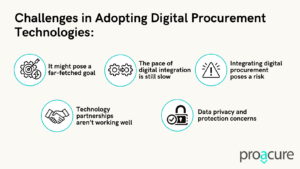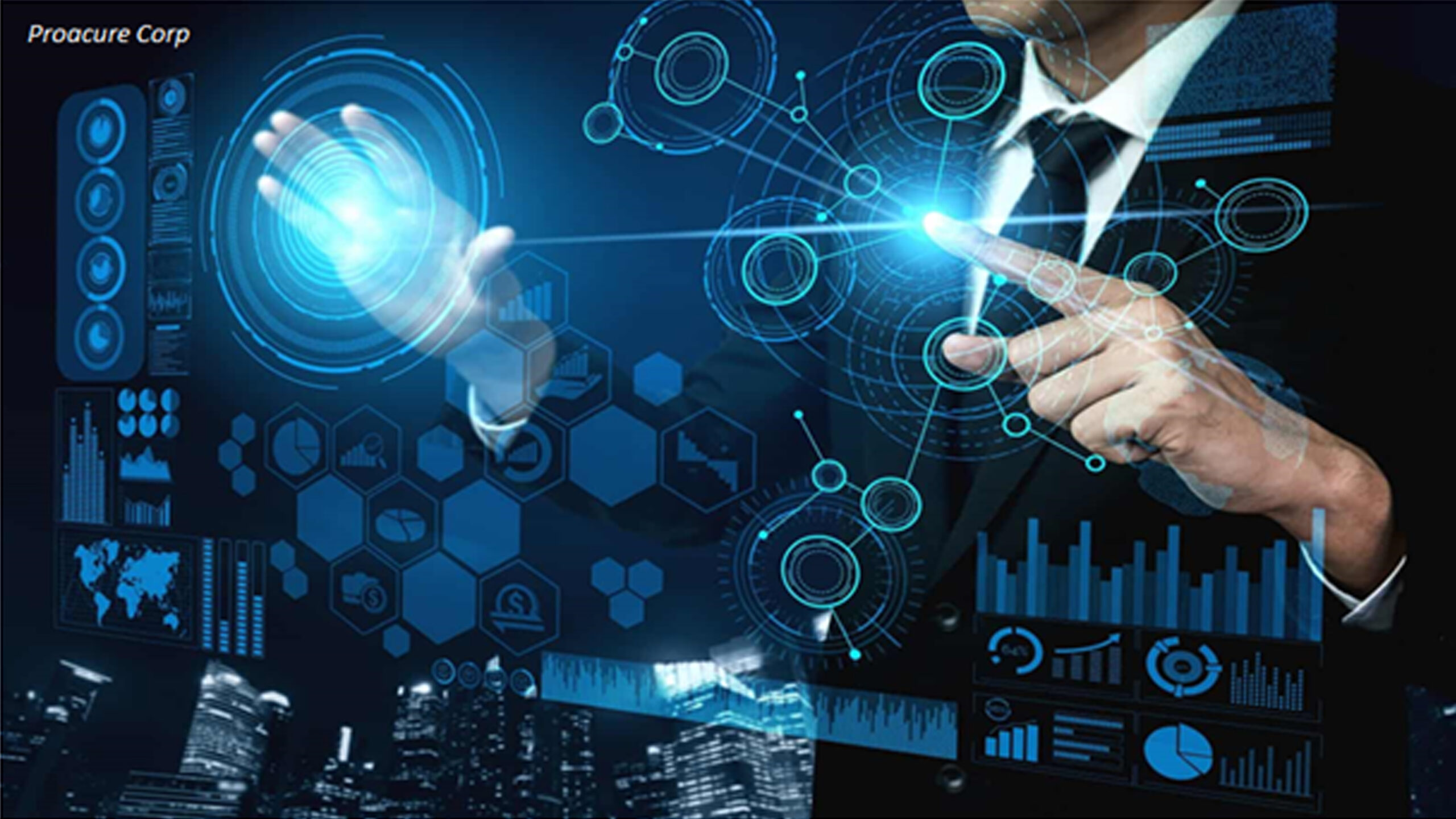Digitizing Procurement & Spend Management
Hersh Agarwal and Ethan Chang, Proacure Research Team | July 24, 2022

Organizations are recognising the necessity of result-oriented, scalable, and creative solutions, and thus focusing on automation of procurement processes, which will allow companies to shift resources to developing other significant tasks.
Introduction
The power of procurement is being recognized across companies today. Digital tools and technologies like Big data and Artificial intelligence have advanced spend analytics, supplier discovery, sourcing and more.
A recent study conducted by McKinsey estimates that close to half of all procurement activities can be automated using technologies that are already available today. For example, AI and ML are used to analyze large data sets from ERP systems via algorithms with minimum effort.
Procurement teams need to realize that the extent of data exploitation and value-addition that can be leveraged from such technologies is large. Such tools give the procurement teams the ability to extract data that was previously unavailable or unstructured from the consolidated base of systems and transform it into information and conduct descriptive spend analytics or build more informed supplier strategies.
Top goals for digitization projects include automating processes, improved data quality, cost savings, and improved compliance. A leading CPO Survey (Deloitte 2019) indicated that 68% of the respondents are improving and automating procurement processes with modern IT applications. However, the adoption of emerging technologies is low. Less than 15% of respondents leverage artificial intelligence, machine learning, 3D-printing and other emerging technologies, according to the survey.
![]()
Digital Technologies
Businesses are gearing toward being more agile to remain competitive in the new landscape: complicated, integrated global supply chains are becoming the norm, and the level of interaction between suppliers, partners and customers is making it difficult to distinguish one from the other. Consumers’ increasing demands for sustainability is driving green procurement, and companies are looking into technology to make it a rewarding strategy. The usage of disruptive technologies like AI/ML enabled software, Big Data, and Robotic Process Automation (RPA) in procurement is fundamentally altering the impact of this function by providing centralized data, enabling automation and moving to repetitive tasks while reducing costly human errors.
According to current trends, automation of procurement processes will allow companies to divert resources to developing other strategic tasks, such as developing agile, well-connected networks of external partners. As the intermediary between the business and its suppliers, procurement will need advanced analytics and the right vision to improve productivity and meet the changing service demands of both the business and its suppliers.
Companies are recognising the importance of result-oriented, scalable, and innovative solutions. Procurement providers, whether within an organization or external, are in turn recognizing the importance of adopting and connecting cutting-edge technologies such as robotic process automation (RPA), artificial intelligence, and smart service to deliver insights to enable smarter and informed management decisions.
Technologies
There are several technologies and solutions ready for deployment. Advanced analytics and data-driven optimization have already proved their value in providing insights for decision-makers and improving efficiency in the procurement function. For example, a major pharmaceutical cut shortened its reporting cycle to 8 days from 30 days, halved its rogue spend, and sped up its program to save $50 million by subscribing to a digital solution for its procurement activities. Automation tools, such as RPA, are transforming downstream procurement activities to save time, cost, and effort.
Below is a brief overview of the existing and emerging ideas that are set to transform business functions.
Spend analytics: involves the consolidation and analysis of an organization’s procurement data. It offers increased visibility into the organization’s supply chain, which can be leveraged by decision makers to formulate strategies to proactively identify saving opportunities. Kearney predicts that 70% of savings will be generated by data analytics. Thus, spend analytics can be the starting point for organizations to delve into digital procurement; this will require organizations to invest in new digital infrastructure and skilled human talent.
Tail spend analytics: a subset of spend analytics. It is an area that many procurement executives find difficult to address on a regular basis and give less priority. The organization’s data often resides in multiple systems including P-card and T&E, so getting an enterprise-wide view, especially for mid and long-tail spend, is increasingly difficult. AI with visibility and opportunity assessment including savings and compliance. Leading procurement professionals have realized that an effective tail spend management represents a substantial opportunity to harvest insights, implement cost reductions, and generate value that meets or even exceeds the expectations set by internal stakeholders.
Techniques
It is impossible for management to make sense of an organization’s data, irrelevant of its size, with naked eyes. This is where visualization shines. Visualization takes data and outputs user-friendly, summarized formats that help users get a descriptive bird’s eye view of their organization’s activities. In addition, predictive, prescriptive, and diagnostic analytics dives deep into the data to indicate problem areas, anomalies, outliers, and red flags. Data is now collected from a wide variety of sources, and is often unstructured or uncategorized. Natural language processing and artificial intelligence are now being leveraged to recognize patterns from this data and deliver key insights and opportunities.
- E-sourcing
e-Sourcing software allows organizations to automate strategic sourcing processes and has the potential to directly impact the supply chain. A comprehensive sourcing strategy includes spend analysis along with the use of online actions to generate significant cost savings. According to Procureport, a correctly customized e-auction software can help an organization save 18% to 40%, depending on the area of spend. E-sourcing provides a digital marketplace for buyers and suppliers to meet. This results in well-organized and transparent workflows and allows companies to have more information and control over their supply-chain.
e-RFX software manages the requests for proposals, bids, or quotations, and the responses in a consolidated digital format that is easy to refer to. Going digital ensures requests are stored in the right format and easy to extract. It optimizes the strategic sourcing process and minimizes paperwork, which is always a welcome benefit to the procurement teams.
- e-Auctions
Reverse online auctions allow suppliers to compete online in real-time. This dynamic, competitive marketplace ensures transparency and has a downward pressure on prices. It helps save cost significantly, and thus impacts the entire supply chain in a positive way.
- Contract lifecycle management
Contract management software creates a one-stop electronic repository for all contract documentation. It removes many of the aspects of physical risk present in paper-based contract management. Automation decreases the risk of human error involved in contract generation and fulfillment, especially when multiple stakeholders are involved. Keeping track of supplier data, trends and performance can be the key to establishing long, healthy, mutually beneficial buyer-vendor relationships.
Features of a comprehensive CLM solution
Risk assessment and mitigation: AI-enabled solutions use natural language processing (NLP) to parse text. They can read documents, identify and categorize clauses, and highlight variations between document versions. This enables the solution to warn users of concerning terms or clauses that may not be in the organization’s interest, and suggest alternatives to reduce risk.
Contract data extraction from legacy contracts: AI combines parsing with NLP, Text Analytics, and Optical Character Recognition (OCR) to extract information from legacy contracts and classify them into clauses, terms, and sections. Documents are presented in a standardized language, which makes negotiations faster.
Automated contract authoring: This is an AI-enabled CLM solution capable of creating contracts automatically by learning from existing records of contracts. It provides suggestions for clauses, which can be reviewed by the user before finalization.
Optimized contract review timelines: With AI-based CLM solutions, all involved functions exist in a single platform. All contracts, along with their relevant clauses and versions, can be reviewed on this platform, giving users the necessary visibility to administer policies and ensure compliance. The end result is a compressed and hassle-free turnaround process.
- Supplier Management
Supplier innovation is a vital aspect of realizing procurement’s new-era strategic goals. McKinsey predicts that in the future, we can expect the buyer and the supplier to work closely, causing enterprises to virtually integrate. Procurement teams will leverage the insights and close relationships they have with a targeted subset of suppliers to drive innovation and strategic activity. For this type of integration to be successful, both buyer and supplier must be completely open about their strategies, plans, capabilities, and limitations. As part of the virtually integrated enterprise, suppliers will be called upon for new ideas and market intelligence, and they will have a crucial impact on the company’s growth strategy. The remaining network of suppliers will have a regular, non-strategic relationship with the company, and their transactions will be highly automated to drive the organization’s focus and time back to the strategically important suppliers.
Below, we discuss some supplier management technologies that can help companies build their next-generation supplier relationships.
Features & Technology Used
Technologies and solutions such as collaboration networks and crowdsourcing are taking supplier management to the next level and unearthing new possibilities.
Collaboration networks allow buyers and suppliers complete visibility into their joint value chains. In addition, supplier information is maintained in the cloud, which users can leverage to analyze and manage supplier performance, identify areas of improvement in joint processes, and uncover and monitor supplier risks.
Crowdsourcing is a novel approach that helps organizations monitor trends that may impact their supply chains by capturing data and sentiment from eclectic sources using mobile technology.
Cyber tracking exposes supplier or supply chain risks; it involves tracking online and offline behavior of suppliers, monitoring their performance, and combining this information with third-party data.
AI can be combined with the aforementioned risk monitoring solutions to take the necessary steps in managing risk by giving prompt notifications and even taking action to mitigate the risk.
In a real-world example, a construction equipment manufacturer saved $1 million in just two weeks using preventative maintenance to identify problems and take preventative measures before problems occurred, thus reducing downtime repair and costs.
- Digitized and Automated P2P
A P2P software integrates the functions of the procurement department with the accounts payable department to ensure the goods and services requirements are met in a timely and efficient fashion. It allows the complete digitization of the mutli-stage P2P process by promoting seamless data exchange, automating repetitive tasks, managing risk, and eliminating manual processing by eliminating paperwork and promoting seamless data exchange.
Robotics
Robotics Process Automation (RPA) software recognizes and learns patterns to replicate rule-based tasks. This technology is used to automate repetitive manual tasks (e.g., some P2P tasks), resulting in increased efficiency and reduced execution error. It frees up resources so the company can divert them to more high-value tasks.
Cognitive Automation
In the P2P domain, cognitive automation combines AI with RPA to replicate the decision-making abilities of the human brain. It uses image processing, text and contextual analysis, NLP, and pattern recognition to even automate decision-making, which is of great value in the P2P cycle, as a delay in one simple task can have major repercussions.
Blockchain
First introduced in 2008 with the advent of Bitcoin, it was adopted to automate P2P processes and make payments secure. It achieves this by requiring all computers in a network to approve a transaction before it is verified and recorded. It enables authorization of vendor transactions, prevents fraudulent transactions, automates risk rating, accelerates purchase order management, and creates a transparent audit trail.
Choosing the Right Software
Many companies have a greater degree of procurement technology already in use, and thus they are not starting from scratch, but simply upgrading their digital arsenal. To do this, businesses have three strategies to choose from: best-of-breed, best-of-suite, or a blend of the two. Choosing the right system depends on the trade-offs a company is willing to make.
Best-of-Suite
The best-in-suite strategy requires commitment to a single end-to-end system from one vendor. In this case, the existing core system (such as Ariba) is replaced by or upgraded to next generation architecture and technology with a hefty one-time investment. While implementing and operating this new system will be easier from the get-go because it comes from the same vendor, companies stand to miss out on best-in-class solutions that excel in their niche. Best-of-suite systems offer little flexibility to integrate standalone technologies, which can make upgrading niche chunks of the architecture difficult, but they are ultimately less expensive and easier to adopt than a collection of standalone solutions.
Best-of-breed
Companies can choose to not subscribe to an end-to-end system but instead enable an agile enhancement of existing procurement technology using a mix-and-match system of best-of-breed solutions. The existing technology backbone cannot be fully upgraded because all standalone solutions may not be compatible with the new technology. This strategy is the least disruptive, future-proof, and has moderate potential for benefits.
Blend
A new technology architecture (for example, an AI hub that all AI-powered standalone software can connect to) is adopted in such a way that it allows the integration of existing and emerging best-of-breed solutions. This system is highly customizable and expensive, but it allows companies to witness and influence the evolution of the procurement function first-hand.
Challenges in Adopting Digital Procurement Technologies

It might pose a far-fetched goal: It has been observed that 67% of procurement decision makers agree that one of their top priorities is to improve the strategic vision of procurement through reporting and analytics. However, integrating new opportunities into their already existing business operations in order to optimize the resulting performance improvement is a major obstacle. Many companies don’t have the resources to determine which area needs digital integration and how to adopt the many technologies available, be it analytics, automation or AI. The result is usually an ongoing debate about which path to take, methodology to use and how to adopt the right digital tools.
Technology partnerships aren’t working well: A study by the Hackett Group in 2019 found that a mere 32 percent of procurement organizations have implemented a digital strategy while only 25 percent have the requisite skills and resources. Companies often lack the knowledge, experience, and vision to identify the right tools that meet their requirements, causing delay in testing and adoption of new trends and strategies and ultimately a loss of competitive edge. This results in technology partnerships that fail to complement management’s aspirations.
The pace of digital integration is still slow: The difference in digital maturity between existing suppliers and the performance levels promised to customers becomes difficult to overcome. Experimentation and adoption of new digital tools are often slow-paced since it requires a well sought after investment by any organization. The final decision depends on whether the technology will reduce the time spent on a task that is being done manually. If the change is slow, procurement executives tend to worry when they don’t see real results early enough or have a heavier workload as a result of the constant changes.
Integrating digital procurement poses a risk:
The internal stakeholders in business may be unwilling to take on new risks that affect existing business as adopting new, disruptive technologies requires flexibility and even a certain amount of trust. Loo Saw Khuan’s (2019) research into the challenges faced by emerging technologies pointed to the fact that procurement professionals are uncomfortable with letting artificial intelligence make decisions for them. Without the right vision and risk-taking attitude, procurement teams may also find the adoption of new emerging technologies difficult in areas where their cost-effectiveness and overall positive influence has not been well-established.
Data privacy and protection concerns: In some high security industries such as the medical and military industries, companies are apprehensive of connecting with suppliers electronically. The security measures to protect data privacy can be inadequate; Kheng and Al-Hawandeh (2002) reported on the security and privacy concerns of Singapore-based firms about their procurement transaction data. These firms faced technical difficulties related to information & data exchange and a lack of common standards prevented easy integration of e-catalogues from multiple suppliers.
Digital Procurement Transformation
Data Management
There would be no analysis, no insights, and no optimization without data. Every department in an enterprise is data-rich, and procurement needs to harness this data efficiently and effectively. Access to rich contextual and third-party data is imperative to help with right decision-making. AI technologies such as machine learning help us clean the data into a uniform taxonomy, natural language processing is important for extracting the contracts metadata and leveraging it to optimize spend and image processing for capturing the pdf invoices to make sense.
In order to truly transform into a digital enterprise, a company needs to record and maintain a central repository of data from processes related to procurement, including invoice and payment data. This means embracing cloud and IoT technologies, refreshing data regularly, and employing and monitoring data quality KPIs.
Talent Pool
Before setting up the data management infrastructure, an organization requires experts from different fields who can use their knowledge to create comprehensive and cost-saving solutions and good reflexes to keep up with the impending transformation. These experts include AI experts and data scientists to build and apply algorithms, category and business experts to advise on the implications or validity of results drawn out by the algorithms, IT experts to build the company’s new digital infrastructure, and design experts to create a seamless user experience.
Policies and Operating Model
To fully benefit from digitization, a company should have clear, up-to-date policies and procedures and ensure all stakeholders – company employees and suppliers – understand their roles and responsibilities in the transformed procurement landscape to make informed decisions regarding fair and secure practice. For example, a purchasing policy makes purchasing goods and services from vendors less ambiguous, prevents conflicts of interest, and makes the adoption of a purchasing system simpler. Similarly, a P-card policy creates a responsive ordering system, prevents maverick spending through identification, and provides an online method for allocation of charges.
Conclusion
In today’s dynamic economy, digital procurement will act as a powerful force for top-line growth while giving bottom-line efficiency. Looking at various successful examples, the traditional procurement leaders are being forced to rethink their operating models. Expectations for procurement are no longer confined to contribution to the bottom line, but are starting to include innovation and growth in the overall process as well. Organizations have begun to adopt digital technology in procurement, which is already transforming the function.
Proacure is a procurement technology & data-science organization based in the San Francisco Bay Area. Our ‘Koreografy’ model leverages multiple frameworks like congruence of different data sets, fusion of digital, analytics and business processes, and synchronous collaboration between various stakeholders. The model enables 100% Spend Visibility with prescriptive actionable insights to transform Strategic Sourcing and help realize untapped value in the Supplier and Tail Spend. Proacure’s deliverables include cost savings of 7-30%, a 20%+ increase in EBITDA, cash flow optimization, and reduced supply-chain disruption.
Related Articles




